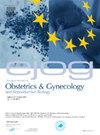夫妇配子冷冻卵母细胞所生子女的认知、情感、交流和运动发育。20 年的单中心经验
IF 2.1
4区 医学
Q2 OBSTETRICS & GYNECOLOGY
European journal of obstetrics, gynecology, and reproductive biology
Pub Date : 2024-09-19
DOI:10.1016/j.ejogrb.2024.09.029
引用次数: 0
摘要
研究对象这是一项单中心人群研究,研究对象为2003年1月1日至2021年12月31日期间在Humanitas生育中心通过冷冻保存卵母细胞体外受精周期出生的所有儿童。主要结果包括各年龄段达到相关里程碑的儿童比例。在小于 6 岁的儿童中,如果有≥ 75% 的受试儿童表达了所测试的能力,则被视为达到了所研究的各年龄人口亚组的里程碑。结果 共有 355 名符合纳入和排除标准的活产婴儿被纳入研究。结果表明,6 岁以下各年龄分组的儿童在问卷调查的所有里程碑中得分均≥ 75%。根据家长的判断,得分最低的里程碑包括同伴间互动(72.31%)和性与情感关系(63.08%)。同样,学龄儿童、青春期前儿童和青少年的情绪健康和社会参与也与同龄人一致。本文章由计算机程序翻译,如有差异,请以英文原文为准。
Cognitive, emotional, communicative, and motor development in children born from couple’s gametes cryopreserved oocytes. A 20 years single-center experience
Objective
To study if social and emotional, communicative, cognitive, motor development of children born from cryopreserved oocytes are comparable to general population.
Design
Survey study.
Exposure
This is a single-center population study, focusing on all children born from cycles of in vitro fertilization of cryopreserved oocytes at Humanitas Fertility Center from January 1st,2003, until December 31st, 2021.
Main outcome measures
General information about birth history were collected from all parents. Then, screening for developmental delay was performed by administration of a questionnaire, edited according to milestones set for age by the Center for Disease Control and Prevention.
Primary outcomes included the percentage of children, for each age range, that reached related milestones. In children younger than 6 years of age, milestones were considered to be reached by each age-based population subgroup studied when ≥ 75 % of included children expressed the tested competences.
Results
A total of 355 live births fulfilled the inclusion and exclusion criteria and were included in the study. Results showed that each age-based population subgroup, younger than 6 years of age, scored ≥ 75 % in all the milestones included in the questionnaire.
In preadolescents and adolescents, it was noted a decrease in unstructured in-person socializing. Indeed, milestones that scored the lowest values, based on parents’ judgement, included tasks concerning peer-to-peer interaction (72.31%) and sexuality and sentimental relationships (63.08%).
Conclusions
Results indicated that the achievement of emotional, communicative, cognitive, and motor milestones in infants, toddlers, and preschoolers was comparable to the general pediatric population. Similarly, emotional wellbeing and social engagement in school-aged children, preadolescents, and adolescents were in line with their peers.
求助全文
通过发布文献求助,成功后即可免费获取论文全文。
去求助
来源期刊
CiteScore
4.60
自引率
3.80%
发文量
898
审稿时长
8.3 weeks
期刊介绍:
The European Journal of Obstetrics & Gynecology and Reproductive Biology is the leading general clinical journal covering the continent. It publishes peer reviewed original research articles, as well as a wide range of news, book reviews, biographical, historical and educational articles and a lively correspondence section. Fields covered include obstetrics, prenatal diagnosis, maternal-fetal medicine, perinatology, general gynecology, gynecologic oncology, uro-gynecology, reproductive medicine, infertility, reproductive endocrinology, sexual medicine and reproductive ethics. The European Journal of Obstetrics & Gynecology and Reproductive Biology provides a forum for scientific and clinical professional communication in obstetrics and gynecology throughout Europe and the world.

 求助内容:
求助内容: 应助结果提醒方式:
应助结果提醒方式:


